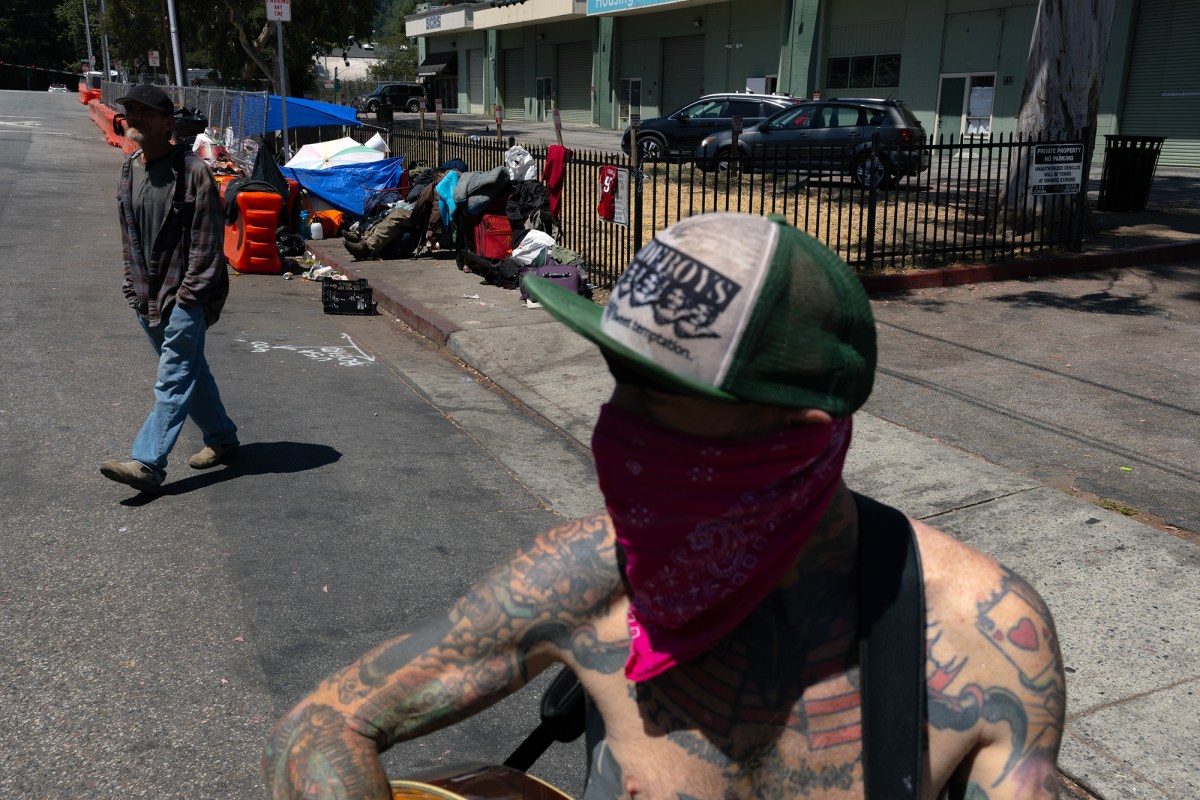In conclusion
Cities in California are subject to a patchwork of disparate laws regarding the removal of homeless encampments.
Greetings from CalMatters, the only nonprofit news organization dedicated exclusively to reporting on topics that impact all Californians. To get the most recent information and analysis on the most significant topics in the Golden State, sign up for WhatMatters.
One of the most difficult and sensitive things a California city can do in response to homelessness is to clear an encampment.
They differ greatly in how they approach that task.
CalMatters requested copies of campsite management regulations from around three dozen California counties and cities. Even though Governor Gavin Newsom is advocating for more integrated regulations, the diverse responses underscored the absence of a unified plan to address street homelessness throughout the state.
For instance, San Diego has a 10-page policy that outlines everything from when removals can occur (during the day and not if there is a 50% chance of rain) to how much notice the city must give camp residents (at least 24 hours) and how to handle personal belongings that are seized during the removal (items must be photographed, logged, and stored for 90 days).
However, some smaller counties and cities have very few or no regulations. There is no campsite management policy in Mendocino County. A little over two pages of the sheriff’s office’s 861-page guidebook address how deputies should deal with homeless people. Instead of making an arrest for little offenses, deputies are urged to think about sending them to counseling and shelter. Additionally, Mendocino County doesn’t keep track of campsite removals.
For the residents of an encampment, many of whom have already endured severe trauma while living on the streets, dismantling the camp can be devastating. However, authorities claim they have a duty to dismantle camps that are hazardous, filthy, could catch fire, or are obstructing traffic.
According to Alex Visotzky, senior California policy fellow for the National Alliance to End Homelessness, having a policy in place can make things easier for everyone by letting residents of a campsite know what to anticipate.
He stated that people must be aware of the arrival time of that garbage truck. People must be aware of the amount of time they have to move. And more damage results when there is absolutely nothing in place and people are merely relying on their instincts. More chaos results from that.
Since many jurisdictions are stepping up enforcement after the U.S. Supreme Court gave them more latitude to do so last year, how towns and counties dismantle camps has become particularly crucial. New laws prohibiting encampments have been approved by cities around the state; these laws may or may not include clauses requiring the municipal to provide prior notice before clearing a camp or storing people’s belongings.
A recent push from the Newsom administration has prompted certain counties, like as Santa Cruz and Monterey, to write encampment policies for the first time. In addition to urging localities to give residents 48 hours’ warning before clearing a camp and to preserve items seized during a clearance so that their owners can retrieve them, he called on them in May to make it unlawful to camp for longer than three days in one location.
Cities and counties must include a link to their camping policy with their most recent application for state funding for homelessness. In the absence of such a regulation, they are expected to pledge to adhere to the state’s directives regarding camps.
The Legislature and the governor’s office have indicated that in order for towns and counties to be eligible for the next wave of funds, which won’t be available until the 2026–2027 fiscal year, they must implement encampment policies.
Tara Gallegos, a governor’s office spokesperson, stated in an email that the governor cannot order cities and other governments to enact a certain plan or ordinance. With the support of billions of dollars in state funds and authority upheld by the U.S. Supreme Court last year, the governor has released a model ordinance and urged all local governments to adopt and implement local laws immediately.
A policy that Santa Cruz County has drafted to control the removal of encampments in the county’s unincorporated areas (almost 600 square miles) will be presented to the board of supervisors next month. Earlier this year, Monterey County established a new policy.
READ NEXT
What to do if your loved one is homeless
According to Robert Ratner, director of Santa Cruz County Housing for Health, the existing procedure for evicting an encampment in unincorporated Santa Cruz County can be somewhat disorganized. It’s not always obvious who agencies should be in charge of deciding which camps to clear, when to do so, and how to do it.
According to Ratner, the sheriff’s office usually makes those calls, but there are a lot of pertinent details that the agency can be unaware of, like the number of available shelter beds or whether the camp is contaminating a nearby river. In addition to providing guidelines on how to conduct outreach (create a list of all camp residents and document information about their circumstances that will help connect them with housing and other services) and how long to store confiscated property (at least 90 days), the new policy places the county executive office in charge of making those difficult decisions.
“Unfortunately,” Ratner added, “it’s not easy.” And I believe the guide is useful in this situation. In order to prevent staff members from being left in the dark, we are taking it to the board, and they will agree to the principles before directing all employees.
However, counties and cities, like Santa Cruz, are hesitant to enact stringent regulations that they could later find difficult to adhere to. For instance, it is difficult to guarantee a shelter bed when you are unsure if one will be available. As a result, rather than providing binding orders, many rules provide ambiguous guidance. Last year, the U.S. Supreme Court decided that local governments have the right to prohibit encampments even in the absence of shelter. Few local encampment regulations go so far as to mandate shelter beds, even if some say that counties and cities should attempt to provide one before demolishing a camp.
Encampment policies that are drafted in court have a tendency to be more legally binding. As was the case in San Diego and San Bernardino, that frequently occurs after a group of homeless citizens sues the city. Following a settlement, the two parties may decide on new guidelines for encampment clearances in that city, which the city is required by law to abide by.
However, that may also result in protracted legal disputes. After eight homeless persons sued the city in 2021, arguing that its enforcement of anti-camping rules was illegal, Chico has been fighting for the past year to escape a settlement.
This settlement established stringent new guidelines. Before Chico can clear a homeless camp, it must now follow. The city must ensure that there are adequate shelter beds available for all of the people who will be forced to leave the camp, give the plaintiffs’ attorneys written notice more than two weeks before the clearance, and give the camp occupants a seven-day warning followed by a 72-hour warning.
People must be aware of the arrival time of that garbage truck.
Supporters of homeless communitiesclaim that the regulations, which are more stringent than those in many other California communities, offer vital protections to those who are merely attempting to survive on the streets. However, the city claims that the lengthy, onerous procedure it must go through before implementing its camping regulations is impeding its ability to remove camps from wildfire-prone areas.
In an email, City Manager Mark Sorensen stated that the City of Chico is not allowed to take reasonable steps to safeguard public health and safety from fire hazards, including the temporary encampments themselves. The seven surviving plaintiffs and their attorneys, Legal Services of Northern California, are holding the city hostage.
Following the U.S. Supreme Court’s decision last year that towns have the right to prohibit camping even in the absence of shelter beds, the city attempted to withdraw from the settlement but was unsuccessful. The city is now making another attempt. Later this fall, the parties are anticipated to appear in court again.
Cities’ policies on the removal of personal property from a homeless camp might also be influenced by legal disputes. San Bernardino, which resolved a lawsuit last year against the destruction of property belonging to homeless people, is required to give camp dwellers bags of different colors so they can distinguish their goods from trash and to give disabled individuals more time to pack up their belongings.
Instead, Stockton follows a police department guideline that ambiguously states that officers should take reasonable care with a homeless resident’s property and refrain from destroying it. Last year, Stockton dismantled more than 200 encampments. Measures should be taken to secure the things if the property owner is unable to box them up.
Most jurisdictions lack the resources to respond to all the encampments on their streets, so some have drafted policies that help them prioritize which camps to clear first. A comprehensive methodology used by Fresno rates encampments according to a number of danger indicators. A camp gets two points if the fire department has had to come out, four points if it s been the location of a violent crime, and one point if a policy maker has asked the city to clear the camp.
Having such a patchwork of policies across the state makes it harder to solve the problem of homelessness, Ratner said. And while Newsom s efforts to get cities on the same page seem to be having some effect, tying those rules to state funding is far from a perfect solution, he said. Smaller cities that don t receive homelessness funds directly from the state have no incentive to adopt rules, he said.
It creates significant inconsistencies, Ratner said, and more drama between the jurisdictions.
READ NEXT
Trump s crackdown on homelessness: What does it mean for California?
They were repeatedly ticketed because of their homelessness. What did it change?
CalMatters has further information.
Text
Receive breaking news on your mobile device.
Get it here
Use our app to stay up to date.
Register
Get free updates delivered straight to your inbox.
Nonpartisan, independent California news for all
CalMatters is your impartial, nonprofit news source.
Our goal remains crucial, and our journalists are here to empower you.
-
We are independent and nonpartisan.
Our trustworthy journalism is free from partisan politics, free from corporate influence and actually free for all Californians. -
We are focused on California issues.
From the environment to homelessness, economy and more, we publish the unfettered truth to keep you informed. -
We hold people in power accountable.
We probe and reveal the actions and inactions of powerful people and institutions, and the consequences that follow.
However, without the help of readers like you, we are unable to continue.
Give what you can now, please. Every gift makes a difference.






